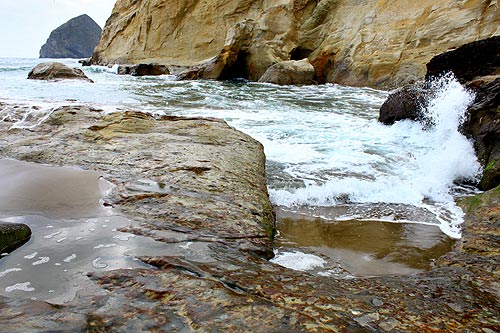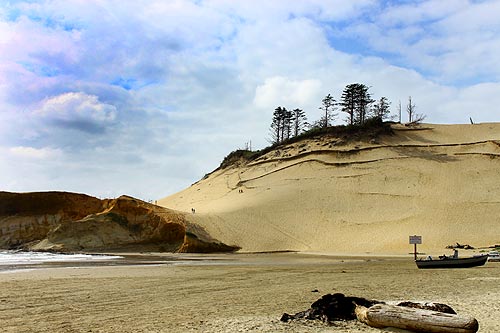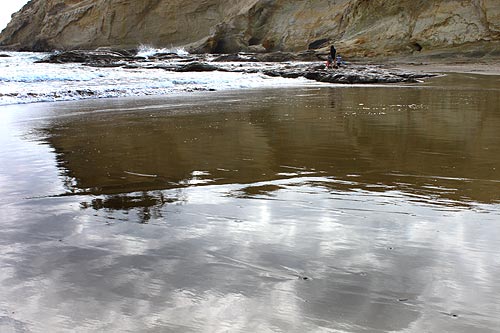 |
Back to Oregon Coast
Contact Advertise on BeachConnectio n.net
An Oregon Coast Icon: One Mile Around Cape Kiwanda
Published 06/24/2011

(Pacific City, Oregon) – Part of it so well known it's literally an icon of the coast. The other part is a relatively hidden beach with a fair amount of not so obvious nooks and crannies.
Cape Kiwanda is of course the big name of the Oregon coast that everyone knows. Below it are half a dozen rocky spots where – given the right tide conditions – you can get pretty close to the water as it washes over or splashes up against. It’s a meandering, labyrinth-like area in some ways, with a variety of sandstone formations of different color patterns. One chunk of rock outstretches close to the main structure and thus forms a little cave of sorts, another rocky slab allows the tide up via a natural ramp, and then there is an actual cave at point.
At lower tides, colonies of sea life open up to the wonder of all.

Up on the headland itself is yet a whole other story, with a huge array of fun finds, including dramatic overlooks, a tiny cove-like area with an odd surprise, a few secret spots you’re not even supposed to go to – and then that mammoth sand dune where the trees resemble the post-apocalyptic world of the “Planet of the Apes” movies and where people sometimes tumble down for the fun of it.

The headland itself is about a quarter mile of wild, untamed beauty and strange rock formations, and the northern side is sadly neglected – but thus much more enjoyable because of the lack of people.
About a mile north of the parking lot for Cape Kiwanda, along the Three Capes Loop, you’ll find an unmarked, one-lane road that mysteriously wanders down a steep hill to the west. This is Cape Kiwanda State Park, otherwise known as McPhillips Beach.

You can drive down on this beach – but it’s not a good idea.
Almost a mile to the south there’s the northern face of Cape Kiwanda, where more of the rock structure becomes apparent, including a dramatic canyon-like area where the sea crashes in big waves and odd, craggy formations sometimes look a little Dr. Suess-like.

Back near the entrance to McPhillips Beach, a small basalt headland juts outward, featuring a couple indentations in the rock that form little places of shelter from the wind. The basalt itself is rather intriguing in texture, with squared formations comprising it in many spots, as if the place was pieced together by Legos.
The end of the structure is interesting as well, with a handful of free-standing upright columns of basalt that are reminiscent of some ancient Roman ruin.


More About Oregon Coast hotels, lodging.....
More About Oregon Coast Restaurants, Dining.....
 |
 |
Secrets of the Season |
Unusual Travel Articles TravelParanormal.com allows you to submit your own creepy tale or debunk one - or see up-to-the-minute news headlines about travel and the paranormal. News Headlines from All Over Oregon Need to scan Oregon headlines? Constantly updated news from all over Oregon: a comprehensive, up-to-the-minute display of news headlines from a variety of media |
Kiwanda Coastal Properties |





































